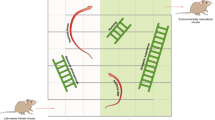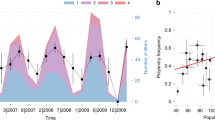Abstract
BECAUSE of the central role of major histocompatibility complex (MHC) genes in immune recognition1–3, it is often assumed that parasite-driven selection maintains the unprecendented genetic diversity of these genes4–7. But associations between MHC genotype and specific infectious diseases have been difficult to identify8,9 with a few exceptions such as Marek's disease10 and malaria11. Alternatively, MHC-related reproductive mechanisms such as selective abortion12–15 and mating preferences16,17 could be responsible for the diversity. To determine both the nature and strength of selection operating on MHC genes by we have studied components of selection in seminatural populations of mice (Mils musculus domesticus). Here we assess MHC-related patterns of reproduction and early (preweaning) mortality by analysing 1,139 progeny born in nine populations, and 662 progeny from laboratory matings. Reproductive mechanisms, primarily mating preferences, result in 27% fewer MHC-homozygous offspring than expected from random mating. MHC genotype had no detectable influence on neonatal (preweaning) mortality. These mating preferences are strong enough to account for most of the MHC genetic diversity found in natural populations of Mus.
This is a preview of subscription content, access via your institution
Access options
Subscribe to this journal
Receive 51 print issues and online access
$199.00 per year
only $3.90 per issue
Buy this article
- Purchase on Springer Link
- Instant access to full article PDF
Prices may be subject to local taxes which are calculated during checkout
Similar content being viewed by others
References
Babbit, B. P., Allen, P. M. & Matsueda, G. Nature 317, 359–361 (1985).
Roy, S., Scherer, M. T., Briner, T. J., Smith, J. A. & Gefter, M. L. Science 244, 572–575 (1989).
Kappler, J. W., Roehm, N. & Marrack, P. Cell 49, 273–280 (1987).
Doherty, P. C. & Zinkernagel, R. M. Nature 256, 50–52 (1975).
Hughes, A. L. & Nei, M. Nature 335, 167–170 (1988).
Potts, W. K. & Wakeland, E. K. Trends Ecol. Evol. 5, 181–187 (1990).
Takahata, N. & Nei, M. Genetics 124, 967–978 (1990).
Tiwari, J. L. & Terasaki, P. I. HLA and Disease Associations (Springer, New York, 1985).
Klein, J. Natural History of the Major Histocompatibility Complex (Wiley, New York, 1986).
Pazderka, F., Longenecker, B. M., Law, G. R. J., Stone, H. A. & Ruth, R. F. Immunogenetics 2, 93–100 (1975).
Hill, A. V. S. et al. Nature (this issue).
Clarke, B. & Kirby, D. R. S. Nature 211, 999–1000 (1966).
Palm, J. Cancer Res. 34, 2061–2065 (1974).
Hamilton, M. & Hellstron, I. J. Reprod. Immun. 19, 267–270 (1978).
Thomas, M. L., Harger, J. H., Wagner, D. K., Rabin, B. S. & Gill, T. J. Am. J. Obstet. Gynec. 151, 1053–1058 (1985).
Yamazaki, K. et al. J. exp. Med. 144, 1324–1335 (1976).
Egid, K. & Brown, J. L. Anim. Behav. 38, 548–549 (1989).
Partridge, L. Phil. Trans. R. Soc. B 319, 525–539 (1988).
Nei, M. & Hughes, A. L. in Evolution at the Molecular Level (eds Selander, R. K., Clark, A. G. & Whittam, T. S.) 222–247 (Sinauer, Sunderland, Massachusetts, 1991).
Karlin, S. & Feldman, M. W. Genetics 59, 117–136 (1968).
Yamazaki, K. et al. J. exp. Med. 150, 755–760 (1979).
Singh, P. B., Brown, R. E. & Roser, B. Nature 327, 161–164 (1987).
Gilbert, A. N., Yamazaki, K. & Beauchamp, G. K. J. comp. Pathol. 100, 262–265 (1986).
Brown, J. L. in Ethical Questions in Brain and Behaviour (ed. Pfaff, D. W.) 111–124 (Springer, New York, 1983).
Uyenoyama, M. K. in The Evolution of Sex (eds Michod, R. E. & Levin, B. R.) 212–232 (Sinauer, Sunderland, Massachusetts, 1988).
Weir, B. S. & Cockerham, C. C. Genet. Res. 21, 247–262 (1973).
McConnell, T. J., Talbot, W. S., McIndoe, R. A. & Wakeland, E. K. Nature 332, 651–654 (1988).
Bronson, F. H. Q. Rev. Biol. 54, 265–299 (1979).
Wilkinson, G. S. & Baker, A. E. M. Ethology 77, 103–114 (1988).
Yokoyama, S. & Nei, M. Genetics 91, 609–626 (1979).
Melvold, R. W. & Kohn, H. I. in Transgenic Mice and Mutants in MHC Research (eds Egorov, I. K. & David, C. S.) (Springer, New York, 1990).
Nadeau, J. H., Wakeland, E. K., Gotze, D. & Klein, J. Genet Res. 37, 17–31 (1981).
Author information
Authors and Affiliations
Rights and permissions
About this article
Cite this article
Potts, W., Manning, C. & Wakeland, E. Mating patterns in seminatural populations of mice influenced by MHC genotype. Nature 352, 619–621 (1991). https://doi.org/10.1038/352619a0
Received:
Accepted:
Issue Date:
DOI: https://doi.org/10.1038/352619a0
This article is cited by
-
Mate genetic similarity affects mating behaviour but not maternal investment in mice
Scientific Reports (2023)
-
Origin and persistence of polymorphism in loci targeted by disassortative preference: a general model
Journal of Mathematical Biology (2023)
-
Similarity at the major histocompatibility complex class II does not influence mating patterns in bluegill (Lepomis macrochirus)
Behavioral Ecology and Sociobiology (2020)
-
Individual Chemical Profiles in the Leach’s Storm-Petrel
Journal of Chemical Ecology (2020)
-
Sexual selection for genetic compatibility: the role of the major histocompatibility complex on cryptic female choice in Chinook salmon (Oncorhynchus tshawytscha)
Heredity (2017)
Comments
By submitting a comment you agree to abide by our Terms and Community Guidelines. If you find something abusive or that does not comply with our terms or guidelines please flag it as inappropriate.



